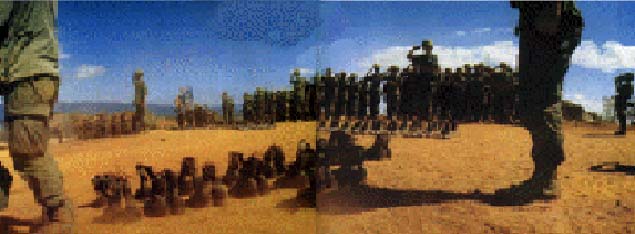
The 173D Airborne Brigade was activated on the island of Okinawa on March 26, 1963. From its beginning, it proved to be an aggressive and unique unit led by (then) Brigadier General Ellis W. Williamson who established realistic training throughout the Pacific Region.
The "TIEN BING," as the Nationalist Chinese paratroopers called the 173d, loosely translated to SKY SOLDIER, made thousands of parachute jumps in a dozen different Pacific area countries. The Brigade was the first Army ground combat Unit sent to the Republic of South Vietnam in May, 1965. The major portion of the brigade landed at Bien Hoa Airfield and found an area that had been battered frequently by enemy raids and shelling attacks.
The 1st and 2nd Battalion of the 503rd Parachute Infantry Regiment along with the 3rd Battalion of the 319th Artillery. comprised the foxhole strength of the 173d. They were well supported by their own Support Battalion and Troop E, 17th Cavalry, D Company, 16th Armour. The First Battalion of the Royal Australian Regiment, and the 105 Field Battery, 1 RAR AUST Group were later attached to the Brigade during the first year. In Late August, 1966, the 173d received another Infantry Battalion, the 4th of the 503rd which arrived from Ft. Campbell, Kentucky. A 3rd Battalion was formed in early 1967 at Fort Bragg, N.C. and was shipped to Vietnam to join the Brigade in August 1967.
In the combat operations to follow, the paratroopers made their superb training payoff. In 1965 on November 11 the 1/503rd in a joint operation with the Aussies from 1RAR overpowered and defeated a VC Battalion. They were the first to go into War Zone D to destroy enemy base camps. They introduced the use of small, long range patrols. They fought the battles of the Iron Triangle, conducted the only major combat parachute jump in the Tay Ninh area, and blocked NVA incursions during some of the bloodiest fighting of the war at Dak To during the summer and fall of 1967, culminating in the capture of Hill 875. Elements of the brigade conducted an amphibious assault against NVA and VC forces as part of an operation to clear the rice-growing lowlands along the Bong Song littoral.
The troopers of the 173D Airborne Brigade (Sep) wear their combat badges and decorations with pride. During more than six years of nearly continuous combat, the brigade earned 14 campaign streamers and four unit citations. 13 Medal of Honor winners, over 6,000 Purple Hearts, the only Combat Parachute Assault of the War, and sadly, over 1700 names of Sky Soldiers on THE WALL. The Brigade was deactivated on January 14, 1972 at Ft. Campbell, Kentucky.
The Brigade was reactivated in 2000 in Vicenza, Italy. No longer a (seperate) Brigade, the 173d became the Southern European Task Force, early intervention element for Europe, Africa and portions of Asia, just as the original unit had the same responsibility in the Pacific prior to deployment to Vietnam. Operation Iraqi Freedom found the Brigade making it's second combat jump. This time into Northwest Iraq to secure the Northern Airfield and area. A year later it was subsequently redeployed to Italy to refit and retrain for deployment to Afghanistan where it is currently engaged in combat operations.
On March 26, 2003, the 173d added to its distinguished history by making the largest mass combat jump since Vietnam when the brigade's Soldiers landed in the Bashur Drop zone effectively opening a northern front in support of Operation Iraqi Freedom. The actions of the brigade caused the Iraqi defenses to commit forces to the area making it safer for swift progress to Baghdad by other U.S. forces. Nine Sky Soldiers made the ultimate sacrifice in support of Operation Iraqi Freedom.
In the spring of 2005, the 173d began its second deployment in three years to Afghanistan in support of Operation Enduring Freedom VI. The 1-508th spearheaded the deployment in February by deploying forces along the Afghanistan-Pakistan border in Regional Command East. The remainder of the brigade deployed to Regional Command South, with all elements of the brigade demonstrating unparalleled bravery fighting anti-coalition forces in the bloodiest spring since original invasion in 2001. The brigade excelled in all aspects of the deployment to include facilitating a peaceful parliamentary election process in the fall of 2005. 17 Sky Soldiers made the ultimate sacrifice in support of operation Enduring Freedom VI.
Today's Sky Soldiers continue the distinction of honored service earned through service dating back to World War I, and proudly represent the airborne fighting spirit with routine training deployments to Bosnia, Kosovo, Hungary, Tunisia, Morocco, Germany, Italy, Czech Republic, and more. These deployments are an important part of CINCEURS theater engagement strategy, demonstrating both a commitment to preserving stability in Europe and the ability to provide immediate response to crisis situations throughout the theater.
